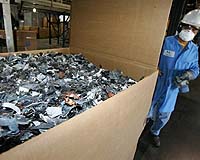| . |  |
. |
West Lafayette IN (SPX) Jun 22, 2009 There may be thousands of things large and small that can be done to better control pollution on even the smallest waterways, and a new tool developed at Purdue University may help sort out how to choose the best ones. Indrajeet Chaubey, an associate professor of agricultural and biological engineering, combined a best management practices tool with a complex genetic algorithm that can search out the best solutions for non-point source pollution control in a watershed. By analyzing data from an area, in just a few hours the tool can compute the most cost-effective pollution-control strategies for water resources affected by agriculture, a process that currently takes weeks or months. A paper on the work appeared this past week in the journal Water Resources Research. "When you have got limited resources to control non-point pollution in an area, you have to decide where to best use your resources," Chaubey said. "At the same time, you want to be sure you don't disrupt the agricultural production in an area." Chaubey has spent the last several years developing a best management practices tool that takes into consideration all feasible solutions for decreasing non-point source pollution, or pollution that gets into water through runoff. The tool determines the best solution - such as changes in tillage practices, grass coverage and structural changes on the land - based on the amount of pollution that can be eliminated, the economic impact to agricultural land and other factors. The calculations used include soil, water, topography and other data usually collected by governmental agencies. The algorithm assesses which of those practices will result in the most pollution control for the amount of money available with as little disruption to agriculture as possible. "You have to look at the economic information at the same time. If the solution we provide will negatively impact farmers, it will not be adopted," Chaubey said. "Combining economic analysis with environmental analysis gives solutions that are more likely to be acceptable to farmers and watershed managers." Current methods used to choose watershed-management practices include funding projects based on a first-come basis or spending on the project or projects seen as most beneficial. The problem is that one major project might break the budget, while several smaller projects could result in better pollution control for the same money. Chaubey said the system was tested with information from the L'Anguille River Watershed in eastern Arkansas. Further testing is being done on six locations in Indiana. The U.S. Department of Agriculture funded the research. Chaubey also expects to develop the tool in a format accessible by government officials to evaluate projects in their jurisdictions. Share This Article With Planet Earth
Related Links Purdue University Our Polluted World and Cleaning It Up
 Fast And Easy Go Green Fundraiser
Fast And Easy Go Green FundraiserWashington DC (SPX) Jun 22, 2009 Recycling 4 Green is one of the easiest and by far most profitable fundraisers available. Simply put, your organization collects used electronics from neighbors, co-workers and parents that will be recycled, helping, in our combined efforts, to save the environment while you get paid for it. After a full box of items are collected, simply print out the FREE shipping labels from our web ... read more |
|
| The content herein, unless otherwise known to be public domain, are Copyright 1995-2009 - SpaceDaily. AFP and UPI Wire Stories are copyright Agence France-Presse and United Press International. ESA Portal Reports are copyright European Space Agency. All NASA sourced material is public domain. Additional copyrights may apply in whole or part to other bona fide parties. Advertising does not imply endorsement,agreement or approval of any opinions, statements or information provided by SpaceDaily on any Web page published or hosted by SpaceDaily. Privacy Statement |